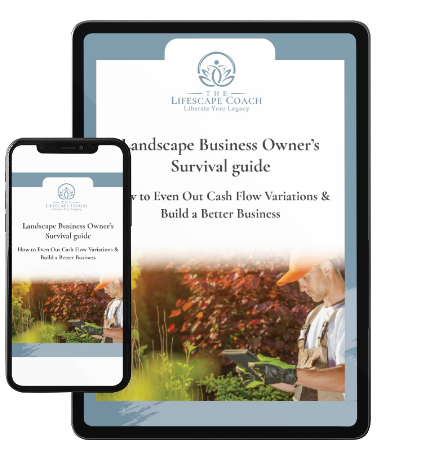How do landscape employees choose the company to work for?
As a landscape business owner and consultant, the biggest challenge I hear about from other landscape company owners is how hard it is to find good help. Many landscape business owners are simply shooting in the dark to find employees for their businesses. They’re looking for warm bodies -- people to do the work at hand, right NOW. They aren’t focusing on the big picture of business development when they’re hunting for staff. They’re just happy to find anyone who can rescue them in the moment.
And therein lies the root of the problem. They’re allowing short-term needs to drive their long-term goals. And that’s no way to run a successful business. If this sounds like you, then it’s time to start thinking of staffing in the same way you think of building a landscape. It’s a process, not a project, and it has to be connected to a long-term vision of what you want your company to be next year, five years, ten years from now.

Here are some key considerations that can help you think more strategically about your staffing so that you can begin building a solid, long-term operation designed to grow a strong client base and increase revenue:
Know why you’re in business.
Long-term employees want to know that the company they are going to work for is solid. Day laborers may not care – they’re just here for the project at hand. But if you want someone who has staying power, then your company needs to have a real purpose and a mission. This is especially true if you want to hire young millennials, because they’re looking for an opportunity to make an impact. They want work with meaning, and you’re not offering that if you’re wishy-washy about why you’re in business.
Identify the central reason you’re in business and write it down. This is what you need to communicate clearly to prospective employees, because you want to find people who think like you do and want what you want. And don’t discount the “day-laborer”. I have been surprised by the staying power and heart that I’ve found in people who started off by saying they just wanted to do manual labor.
Answer these three fundamental questions:
- Why is your business in existence – what is its purpose?
- What is its mission -- the thing that drives you to do what you do every day?
- How do you go about making all that a reality?
Be the employer you’d like to work for.
Good employees look for strong, compassionate, smart, and engaged leaders. Gone are the days of being a bully boss and getting away with it. It is far more helpful and constructive to lead by example, to set a tone and a standard that compels the right people to want to work for and with you.
Once you find the right people it’s important to trust them and give them increasing responsibility as they earn it. Start by understanding what it is you do best. What is it that only you can do and that provides the most benefit for your company? Everything else can and should be delegated to really good staff. Make a list of those things. Be clear about why they are valuable to you and to your business. Because value is what makes a job compelling, not the just the pay. Good employees will work harder and take more pride in what they do when they know their work is valuable and valued.

Give employees a ladder up.
Employees today would rather work at a service station or coffee shop that provides them with a growth ladder over working for a landscape company that’s just looking for warm bodies to dig holes. To keep good employees you have to give them hope. Hope that they can learn new skills and earn new responsibilities. Hope that there’s room for growth at your company. That’s why it’s important for you to understand your business – so you can chart a path for growth and show employees that there’s a ladder up for them.
To accomplish this, develop an organization chart that pinpoints the hierarchical location of each and every job: who leads, who manages, who supports who, who does what. If you as the owner don’t understand the value of each position you can’t communicate its value to employees.
Growth is the key to success. Being able to show a track for promotion and advancement within your company will be key to hiring and retaining the employees who can help create that growth and success.
Knowledge is the glue that holds everything together.
Some employers mistakenly believe that the less employees know the better. Nothing could be further from the truth.
The more employees know, the more they feel empowered – and valued. Employees want to know that they have control over their experience, their advancement, and their daily activities. If the staff you need to hire is low on the organization chart, be fair to them by outlining the job clearly and realistically, but let them know that you or someone else in your company will be available to mentor them and help them grow into a better job.
Providing training is a way to communicate your dedication and commitment to the development of your staff. Stop being stingy in this area because you think workers will learn from you and leave. Yes, they will – that’s just par for the course, regardless of the company or industry. But when you’ve done Key Points 1-3 as outlined here, you will be delighted to learn that you’re actually developing a loyal staff that wants to stay with you because they can see you have their best interests in mind.
Compensation is key.
Employees want to be compensated fairly and justly. They want a decent wage and they want benefits. While money certainly talks, there are myriad other forms of compensation that will keep an employee loyal and dedicated to you and your company. Be willing to get creative with how you provide for your employees.
Payscale is important: start here, perform well, advance to there. Link performance, position, and growth to a payscale. But remember, it’s not just the paycheck. Benefits are important, too – treat your people like humans. There is no reason why you should burn out a low-level employee with no benefits and give all the perks to higher level staff. Spread the love. Make sure you are presenting benefits as a value-add to all position levels. And yes, benefits can evolve and increase with seniority. But if the employee can’t see the ladder to gain seniority, the job’s a dead end, as far as they’re concerned.
The lessons I’ve learned.
I’ve been employing people for almost thirty years and it has been a LONG road of trial and error, joys and tears. Being an employer is harder than any other thing in business. The only other thing harder in life is being a parent. In fact, they’re very similar. People are HARD and if you have personal triggers, hot buttons, and issues – and we all do – employing people can be an emotional rollercoaster. The five points I discussed in this post will go a long way in helping you with your recruiting and retention strategy and just maintaining an even keel.
But, you may be thinking, I’m a landscaper. All this employee stuff sounds like HR talk in a big corporation, not something I have to worry about. Well, sorry. If you own a business and have employees then, first and foremost, you are an employer. Come to terms with that and learn to be good at it. Take it seriously because people looking for jobs and careers these days want to be taken seriously.
It’s important to understand that you cannot coerce people into behaving as you wish. Be clear with yourself why you’re in business and where you want your business to go. Communicate that clearly with the people you’re considering hiring and choose the ones who align with your way of thinking.
Be honest, be transparent, be supportive, and be willing to learn from the people you hire. Those are the traits good employees look for in an employer. When you willingly choose each other, everyone wins.
Landscape Business Owners Survival Guide



